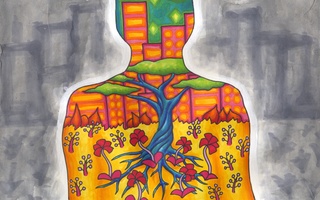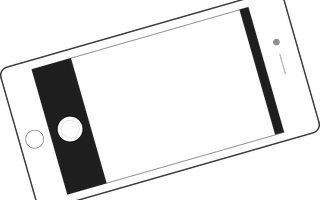{shortcode-fe84b57813c66471cf5f67025f63096c8a4eb4ff}
I’ve spent countless conversations defending abstract art — paintings like a red line slashed over a blank white background, or shapeless layered scribbles and splatters, or multicolored boxes suspended across a canvas. The kind of art that makes people scoff and conclude that “any child could have made it.” The kind of art that I, too, used to consider boring, pointless, and overly simplistic.
But my mindset began to shift in a painting class at Harvard last year. Sitting through lectures showed me how to truly contemplate paintings that I would have dismissed in seconds on my own. And when assignments demanded that I make the kind of art that I didn’t like or understand, I realized that an incredibly time-consuming and complex process goes into creating simple-looking paintings.
Because simplicity forces artists to whittle their art down to its barest, most basic elements. And it forces viewers to work hard for comprehension. Unlike photorealistic art, for example, nobody can look at an abstract painting and instantly understand it. Each detail matters, but its significance is elusive. There’s no “right” reason to explain why a certain shape’s mismatched edges don’t form a perfect square, why a particular combination of colors is oddly jarring, or why a specific line travels along jagged angles, rather than through smoothly meandering curves.
It’s easy to answer these questions by deeming the artwork aimless and arbitrary, something “any child could have made.” But it’s much more interesting to view these works as interpretive puzzles, exercises for the imagination, inviting artists and viewers to somehow make sense of what they’re seeing. We can transform abstract art into a streamlined version of reality, a representation of actual images and events, or even a simple narrative about balanced, bizarre, or surprising relationships between shapes, colors, and lines.
And humans are built to generate meaning out of simpler things. We stare at the clouds to construct shapes, pictures, animals, and people from drifting water vapor. We connect random clusters of stars into constellations that tell stories. We can’t help but see faces in inanimate objects everywhere — trees, wall sockets, car bumpers, or Jesus famously burnt into toast. And we can translate extraordinarily minimalist symbols like “:)” or “:(” or “:/” into complex emotional perceptions.
Yet so many people seem to be averse to simplicity. This aversion manifests itself in negative responses to abstract art (my own initial response included). But it also manifests in so many other areas — like the joke about a physics problem that “assumes a spherical cow in a frictionless vacuum,” which critiques oversimplification in scientific and mathematical modeling. The real world is impossibly complicated, so simplicity can be seen as a failure, something detached from reality, unable to tell us anything practical or useful. And this same aversion is manifested in our everyday lives.
At Harvard, people tend to complicate rather than simplify. There are always more meetings, lunches, lectures, clubs, comps, shows, or practices to squeeze into our calendars. And our jam-packed academic, extracurricular, and social lives are often scheduled down to the minute. We’re more enthusiastic to take on responsibilities than to drop them. And I think that sometimes we forget to ask ourselves why.
Valuing simplicity doesn’t mean that we should indiscriminately slash our schedules, cut down our activities, or seek to accomplish the bare minimum. It just means that we should take the time to contemplate everything we’re doing in broad strokes, with the same meditative energy that allows us to look at an abstract painting and find a bridge between its complexity and simplicity. The day-to-day workings of our lives can and will be complicated and difficult, but our overarching goals and values tend to be much clearer. And it’s important to make sure that these two facets align with each other. We often feel like we have to take certain classes, join certain groups, pursue certain leadership positions, aim for certain jobs — but there’s no point to doing so if they won’t bring us happiness, won’t reward and fulfill our values, won’t actually help us realize our dreams. It’s okay to simplify our lives when simplification ultimately preserves these core underlying goals.
Simplicity and complexity are two sides of the same coin. They teach us the most when we join them together: Abstract art and reality, spherical cows and living ones, our broader aspirations and the countless daily steps we take to get there. Without complicating interpretations, abstract art remains dismissible, boring, arbitrary — in the same way that, without concrete actions to achieve them, our aspirations remain abstract and unattainable. And we must always stay faithful to these broader aspirations to the simplest reasons why we wake up every morning and make it through the daily grind, in order to give it greater meaning.
Isabella C. Aslarus ’21, a Crimson Design editor, lives in Leverett House. Her column appears on alternate Tuesdays.
Read more in Opinion
End Shopping WeekRecommended Articles
-
Art19th Century America at the Metropolitan Museum of Art, April 16 - September 7LIFTED from the walls, packed and shipped, paintings from the exhibition of contemporary New York art have abandoned the Metropolitan
-
 On True Illusions
On True Illusions -
Roving Reporter: Boston Media, Arts & Ideas MixerLast Monday evening, the back room of Brattle Street’s Beat Brew Hall transformed into the second Boston Media, Arts & Ideas Mixer. Over drinks, popcorn, and pretzels, the event brought together creative individuals from the Boston area — across all academic and professional disciplines — in a vibrant, friendly, and inclusive environment. It fostered conversations about past accomplishments, current projects, and future ideas, and served to introduce creators (in many forms) to potential future collaborators. This Roving Reporter spoke to some of the mixer’s attendees to learn more about them and about Boston’s creative scene.
-
 Facing Off Against Artificial Artists
Facing Off Against Artificial Artists -
 The Threat Against Communication
The Threat Against Communication













